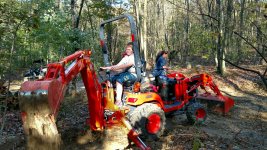Rock Crawler
Veteran Member
- Joined
- Aug 15, 2017
- Messages
- 2,224
- Location
- Pittsburgh, Pa.
- Tractor
- 2021 Kubota L3560 HSTC, 2011 Craftsman Excellerator GT (680hrs), 2018 Husqvarna TS354XD, 2017 Husqvarna HU800AWD, 2019 Kawasaki Mule Pro DX (Yanmar)
My father owned a home construction for years and used large equipment, one item was a large old Case loader/backhoe that they used on job sites. So when I picked this little Kubota BX25 up, he was happy to come over and show me how to use it. He told me that they always put the loader bucket down with the blade into the dirt to help hold the tractor into position because you would otherwise easily pull the outriggers through the dirt, it was just another added resistance added to help allow you to do more work with the available backhoe strength.
So I posted on Facebook a photo of my son using the backhoe to dig out small tree root balls, and someone commented pretty quickly that I should lay the bucket on the loader down flat because I will damage the loader curl cylinder using it in this position. That confuses me a bit... This is the cylinder that I use as I am spinning tires forward in 4x4 to curl the bucket up if I stop moving (and still spinning tires) or add more downward curl once it starts moving again. That digging should be putting a heck of a lot more stress on the cylinder than it is in this position and simply being at rest (in respect to hydraulic input) with the blade being use for positional stability.
Is there something that I'm missing here? The hydraulic ram is intended for digging, curling, taking stress loads and such. I can't imagine that the ram will fail from this, and I don't expect it to fail from digging. Isn't that why they build and sell these things to us? My expectation is that the build is such that you can use the machine up to it's limitations with minimal fear of damage outside of normal wear and tear with resulting periodic maintenance and repair.
So I posted on Facebook a photo of my son using the backhoe to dig out small tree root balls, and someone commented pretty quickly that I should lay the bucket on the loader down flat because I will damage the loader curl cylinder using it in this position. That confuses me a bit... This is the cylinder that I use as I am spinning tires forward in 4x4 to curl the bucket up if I stop moving (and still spinning tires) or add more downward curl once it starts moving again. That digging should be putting a heck of a lot more stress on the cylinder than it is in this position and simply being at rest (in respect to hydraulic input) with the blade being use for positional stability.
Is there something that I'm missing here? The hydraulic ram is intended for digging, curling, taking stress loads and such. I can't imagine that the ram will fail from this, and I don't expect it to fail from digging. Isn't that why they build and sell these things to us? My expectation is that the build is such that you can use the machine up to it's limitations with minimal fear of damage outside of normal wear and tear with resulting periodic maintenance and repair.

